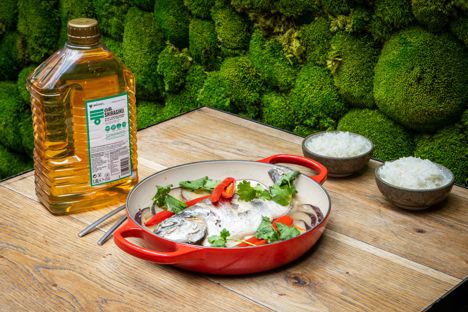
Ingredient Focus: Shiragiku vinegar
Brewed with both sake lees and rice extracts to give it an added depth of umami, Mizkan’s Shiragiku vinegar is the ultimate way of heightening the flavour of all sorts of different dishes. We find out more about what makes Shiragiku such a unique ingredient.
Ingredient Focus: Shiragiku vinegar
Brewed with both sake lees and rice extracts to give it an added depth of umami, Mizkan’s Shiragiku vinegar is the ultimate way of heightening the flavour of all sorts of different dishes. We find out more about what makes Shiragiku such a unique ingredient.
Whether used for preservation, in sauces or simply as a condiment, vinegar has been present in cookery for thousands of years and over time, countless different styles have been developed, each with their own flavour nuances and uses. For over two-hundred years, Japanese producer Mizkan have been experimenting with different brewing techniques to create vinegars that have their own distinct taste. One such vinegar is their Shiragiku – a unique spirit vinegar originally produced for bringing added umami to Japanese dishes specifically, but which can in fact be used to take all manner of different cuisines to the next level.
Originally launched in 1951, what makes Shiragiku vinegar different from so many other vinegars is the use of sake lees in its production along with its incredible versatility. Sake lees are the residue left over when producing the famous Japanese rice wine and have an intense umami flavour. Mizkan allow these lees to age until they go a brownish colour and then add them to alcohol before acetic acid fermentation takes place (the process by which alcohol is turned into vinegar). Brewing the Shiragiku with these sake lees results in it taking on a complex umami flavour, unlike other vinegars. The benefits of using Shiragiku rather than other, less complex vinegars are therefore clear for all to see – it takes dishes to the next level in terms of both depth and complexity of flavour.
When Shiragiku was initially produced, it quickly gained popularity in Japanese restaurants, due to the way in which its mellow acidity and rich umami tang complemented sushi in particular. However, its complex flavour means that it’s actually an incredibly versatile ingredient, and is the ultimate way of dialling up flavour in all sorts of different cuisines. One such cuisine is Filipino food, which relies more on vinegar than most styles of cookery but typically uses cane and coconut vinegar, as large quantities are produced in the Philippines.
London-based Filipino chef Budgie Montoya, who has made it his mission to showcase the flavours of the Philippines in a modern way, recently used Mizkan’s Shiragiku in two of his recipes to really amp up the levels of flavour. ‘It’s definitely a much more complex flavour than your basic vinegars,’ says the Sarap founder, ‘vinegar is one of the key ingredients in the Philippines, so it was interesting to try something a bit different and adjust accordingly. I’d say the Shiragiku is stronger and less sweet than traditional Filipino vinegars, so I found that I could reduce the amount I was using.’
Widely regarded as the unofficial national dish of The Philippines, adobo is a type of traditional stew made with meat or fish that’s been marinated in vinegar. ‘It’s not just the case that every household has its own adobo recipe,’ explains Budgie, ‘each member of every family probably has one.’ By using Shiragiku in his own take on this classic dish, Budgie added further complexity to his adobo in a way that other vinegars would struggle to do, ‘I added a bit less vinegar than I normally would in an adobo,’ he says, ‘and that helped me achieve a really mellow flavour.’
The deep umami flavour of the Shiragiku was showcased further in Budgie’s take on another highly traditional Filipino dish, sea bream paksiw (which literally translates as ‘to cook in vinegar). Given that this dish originally grew out of the necessity to use vinegar to preserve ingredients before refrigeration existed, the Shiragiku unsurprisingly plays an essential role in Budgie’s recipe and imparts a distinct flavour to the bream. ‘There’s no hiding in terms of the flavour of the vinegar you use when it comes to paksiw,’ says Budgie, ‘it’s really important to use one that has a bit of flavour to it rather than just a basic vinegar, and that’s why the Shiragiku worked so nicely. I actually found that it brought out a bit of nuttiness.’
The fact of the matter is that there isn’t really a wrong way to use Shiragiku, both in terms of cuisine and also whether it’s cooked into a dish or served raw as part of a dipping sauce. ‘It’s definitely a very versatile vinegar,’ says Budgie, ‘its lack of astringency helps because it means you’re not getting that acidic feeling in the back of your throat like you get with a lot of European vinegars.’ The combination of this versatility and Shiragiku’s complex flavour is what makes it so unique. It may have initially found fame in Japanese kitchens, but the fact of the matter is that this is a vinegar which should be a stalwart of any kitchen, thanks to its unique ability to add mellow acidity and an umami tang to all kinds of different dish.


